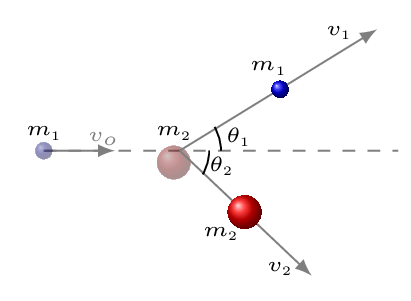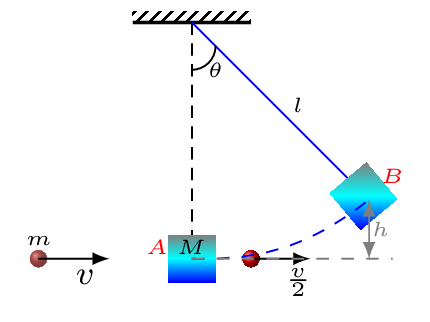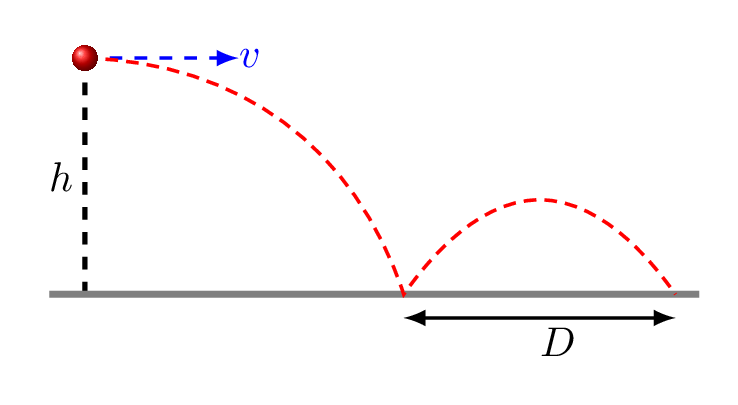Case I: Perfectly inelastic collision.
Given: \(m_{1} = 2 \,kg,\quad v_{1i} = 40 \,m/s, \quad m_{2} = 3 \,kg,\) \(\quad v_{2i} = 10 \,m/s,\quad v_{1f} = v_{2f} = v\)
\begin{equation*}
p_{i} = p_{f},\quad p_{i} = m_{1} v_{1i} - m_{2} v_{2i}, \quad p_{f} = m v_{f},
\end{equation*}
\begin{equation*}
m = m_{1} + m_{2}, \quad v_{f} = 10 \,m/s
\end{equation*}
\begin{equation*}
e = \frac{v_{sep}}{v_{app}}= 0 \quad \text{(inelastic collision)}
\end{equation*}
\begin{equation*}
\Delta E = E_{i} - E_{f},\quad E_{i} = \frac{1}{2}m_{1} v^{2}_{1i} + \frac{1}{2}m_{2} v^{2}_{2i},
\end{equation*}
\begin{equation*}
E_{f} = \frac{1}{2} m v_{f}^{2},\quad \Delta E = 1500 \,J
\end{equation*}
Case II: The first mass stops.
Given:
\begin{equation*}
m_{1} = 2 \,kg,\quad v_{1i} = 40 \,m/s,\quad m_{2} = 3\, kg, \quad v_{2i} = 10 \,m/s,\quad v_{1f} = 0
\end{equation*}
\begin{equation*}
p_{i} = p_{f},\quad p_{i} = m_{1} v_{1i} - m_{2} v_{2i},\quad p_{2f} = m_{2} v_{2f},\quad v_{2f} = 16.67 \,m/s
\end{equation*}
\begin{equation*}
e = \frac{v_{sep}}{v_{app}}, \quad v_{sep} = v_{2f}, \quad v_{app} = v_{1i} + v_{2i}, \quad e = 0.3333
\end{equation*}
\begin{equation*}
\Delta E = E_{i} - E_{f},\quad E_{i} = 1/2 m_{1} v^{2}_{1i} + 1/2 m_{2} v^{2}_{2i},
\end{equation*}
\begin{equation*}
E_{f} = 1/2 m_{2} v_{2_{f}}^{2}, \quad \Delta E = 1333\, J
\end{equation*}
Case III: Perfectly elastic collision.
Given:
\begin{equation*}
m_{1} = 2 \,kg,\quad v_{1i} = 40 \,m/s,\quad m_{2} = 3 \,kg,\quad v_{2i} = -10 \,m/s, \quad e = 1
\end{equation*}
\begin{equation*}
p_{i} = p_{f}, \quad p_{i} = m_{1}v_{1i} + m_{2} v_{2i}, \quad p_{f} = m_{1} v_{1f} + m_{2} v_{2f},
\end{equation*}
\begin{equation*}
\quad e = \frac{v_{sep}}{v_{app}}, \quad v_{sep} = v_{2f} - v_{1f},
\end{equation*}
\begin{equation*}
v_{app} = v_{1i}- v_{2i}, \quad v_{1f} = -20 \,m/s, v_{2f} = 30 \,m/s
\end{equation*}
\begin{equation*}
e = 1\quad \text{(elastic collision)}
\end{equation*}
\begin{equation*}
\Delta E = E_{i} - E_{f}, \quad E_{i} = 1/2 m_{1} v^{2}_{1i} + 1/2 m_{2} v^{2}_{2i},
\end{equation*}
\begin{equation*}
E_{f} = 1/2 m_{1} v^{2}_{1f} + 1/2 m_{2} v_{2f}^{2}, \quad \Delta E = 0 J \quad \text{(elastic collision)}
\end{equation*}





